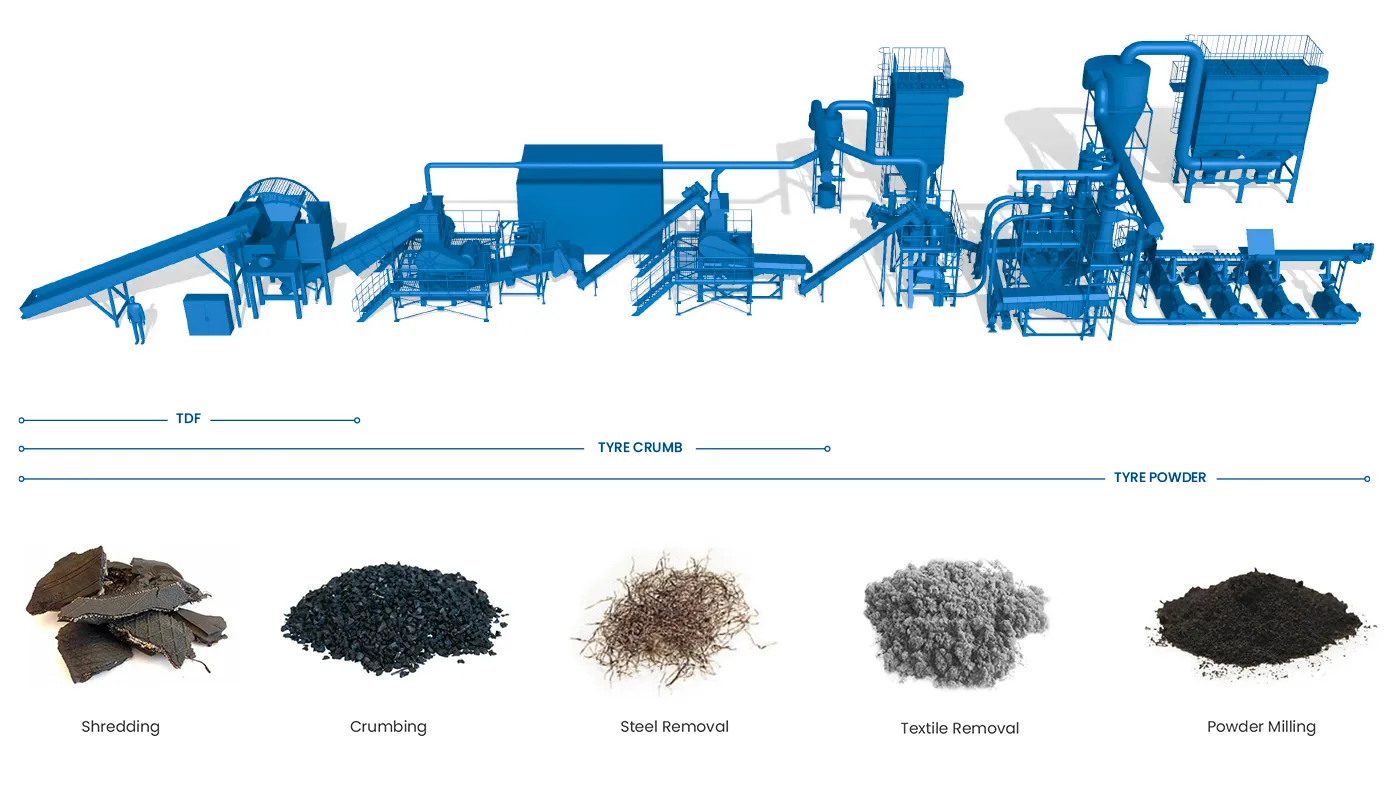Tire recycling plays a pivotal role in addressing the global environmental crisis caused by the disposal of millions of used tires annually. With over 56 million tires processed each year in many countries, establishing effective tire recycling systems is essential for sustainable waste management and environmental preservation.
Why Tire Recycling Matters
- Environmental Impact
Discarded tires often end up in landfills or illegal dumping sites, leading to severe environmental issues such as soil contamination and fire hazards. Recycling mitigates these impacts by transforming waste into valuable materials, thereby reducing the ecological footprint. - Economic Benefits
Tire recycling fosters the creation of new industries, generates employment opportunities, and contributes significantly to the economy. It converts waste into rubber granules, tire-derived fuel (TDF), and fine rubber powder, which are utilized in diverse applications like asphalt modification and sports surfaces. - Resource Optimization
Tires are composed of rubber, steel, and synthetic fibers, all of which can be recovered and reused in various industries. This process not only reduces the demand for raw materials but also minimizes energy consumption in production processes, promoting a circular economy.
The Tire Recycling Process: A Step-by-Step Breakdown
Step 1: Primary Tire Shredding
Primary shredders initiate the tire recycling process by reducing whole tires into 50-100 mm rubber chips. These chips meet export standards or are prepared for further processing, such as conversion into TDF. This stage is crucial for both standalone facilities and larger recycling plants.
- Configuration Considerations:
Select shredding systems based on tire types and desired output capacity. Factors like steel content and processing volume significantly influence system design.
Step 2: Tire Granulation
Tire granulators process TDF into finer rubber granules ranging from 1 mm to 4 mm. This phase separates rubber from steel and textile fibers, resulting in high-quality rubber particles.
- Key Components in This Stage:
- Magnetic Separators: Remove steel contaminants to ensure clean rubber granules.
- Granulators: Ensure precise particle sizing for various applications.
Applications of tire granules include asphalt modification, sports fields, and rubber product manufacturing.
Step 3: Rubber Powder Production
The final stage of tire recycling involves converting rubber granules into ultra-fine rubber powder.
- Process Details:
- Grinding Machines: Rubber granules pass through grinding mills that shear material into fine powder using rotating grinding plates. The result is rubber powder with particle sizes ranging from 40 to 80 mesh.
- Vibrating Screens and Classifiers: Separate fine rubber powder from coarser particles and residual fibers, ensuring consistent quality.
Advantages of Recycled Tire Products
- Rubber Granules and Powder: Utilized in road construction, rubber mats, and playground surfaces.
- Tire-Derived Fuel (TDF): A cost-effective and energy-efficient alternative for industries such as cement and steel.
- Steel Recovery: Recycled steel from tires is reused in manufacturing processes.
- Textile Fibers: While challenging to repurpose, ongoing innovations explore their use in composite materials.
Enhancing Efficiency in Tire Recycling
To optimize your tire recycling plant:
- Invest in High-Quality Equipment: Machines like primary shredders, granulators, and grinding mills ensure efficient material processing and minimal waste.
- Incorporate Advanced Separation Systems: Magnetic separators and fiber removal systems enhance the purity of recycled materials.
- Ensure Compliance with Regulations: Meet local and international standards for tire-derived products to expand market opportunities.
Conclusion
Tire recycling is more than an environmental obligation—it is a lucrative opportunity to transform waste into valuable products. From shredding to granulation and powder production, every stage of the process has its purpose. By adopting advanced systems and techniques, recycling facilities can achieve sustainable operations while contributing to a greener future.
For more insights on sustainable waste management, explore our solutions for recycling systems.



